Pad Thai With Shrimp has rich flavors that emanate from noodles flash cooked under high heat with a curry paste and a variety of ingredients. In theory, you can use whatever is leftover in your refrigerator from chicken to shrimp to tofu.
Pad Thai With Shrimp is just as tasty as the one with both shrimp and chicken. It is one of those dishes that is both easy and quick to make. On a cold day, there is nothing as summery and tropical as a steaming plate of Pad Thai With Shrimp. It is one of those dishes that can claim to be a true national dish of Thailand. Urban legend has it that it was created in the the1930s as a consequence of both war and flood. What can be more Thai than stir-fried noodles spiced with local ingredients such as peanuts, tamarind, and palm sugar? In case you are wondering, “Pad” in Thai food means “fried”.
My inspiration for making Pad Thai With Shrimp from scratch:
I first came across Pad Thai made with shrimp when I was vacationing in Bangkok many years ago. The tour guide took us to Thipsamai Pad Thai, one evening. Little did I know that this unassuming restaurant was the most famous Pad Thai shop in Bangkok. They serve their charcoal-cooked noodles wrapped in an omelet with prawns. I became an instant fan. Over the years, I have tried Pad Thai in various countries. They were all flavorful and slightly different based on the ingredients that were locally available, but Thipsamai is still the one that I remember.
Thai cooking is apparently more about the about ease of preparation. Their cuisine is generally quick to make, thus making meal-prep not so cumbersome. This ease of cooking frees up their day, making room for other activities.
The indulgent Pad Thai has a reputation of being less than healthy. Done badly, Pad Thai is essentially noodles fried with a lot of oil, accompanied by a sugar and sodium-rich sauce. That is one way to get the flavor.
My version is healthier. I like using oil sparingly and letting the fresh ingredients and sauce speak for themselves. Over the years, I have experimented with a variety of noodles, oil, and sauces. The commercial premade Pad Thai sauces tend to have a lot of additives and preservatives and are a little on the sweeter side. While I love shrimp, I also tend to add more crunchy vegetables that make the dish a lot healthier than what is served at local Thai restaurants.
This recipe has my version of the Thai curry paste that is homemade. This makes the difference. If you think about flash fried noodles, the one common theme is that they are quick. While talking about preparing Char Kway Teow, a South East Asian noodle dish, it is mostly about convenience. No one has the time to sweat over a stove for hours. Hawker centers or food courts tend to be “fast food”, which means that from the time an order is placed to when it is served, it should take no more than 5 to 10 minutes. That is why pre-making the sauces is so essential.
Come time for dinner, just rehydrate your dried noodles, and rummage around your kitchen for tofu or diced chicken or shrimp. By the time the wok is hot, you add your ingredients and cook for no more than 10 minutes. Voila! A whole new definition of healthy and tasty fast food. Splash some lime juice over your still steaming noodles and garnish with crushed peanuts. It tastes million times better than soggy takeout. I try and make stars out of unusual ingredients in my recipes, and in my Pad Thai, the fresh, crunchy sugar snap peas are the stars. Unlike other South East Asian noodles, I find that the Pad Thai is the most accommodating, in that you can vary the vegetables and protein and it can still taste great.
If you can’t tell, I’m a fan of noodles. Given a choice of rice or noodles, I more than likely will lean toward noodles. They’ve become comfort food for me, which is a strange thing for a rice-centric South Asian. There’s something very basic and simple about them. I sometimes ponder why noodles could not only nurture but also comfort me. Noodles are basic and simple, more like an every day meal, yet they help sustain me. The very texture of noodles and the wonderful feeling that we get when we eat a bowl of soupy noodles or the fried ones have the power to uplift.
It could also be attributed to the carbohydrates in the noodles that makes them enticing and appealing. I love that you can use them in a soup, in a stew, or sauté them. Before I forget, Pad Thai is not a stew, and it is not pasta with sauce sprinkled on it, nor can you use ketchup. It’s a spicy, high flame, ‘wok-hei’ inspired bit of culinary heaven.
You could also try my Pad Kee Mao Recipe if you like Thai fried noodles.
Veggie option:
You could make Pad Thai with vegetables by excluding the shrimp and the fish sauce. Add your favorite vegetables such as carrots, zucchini, and broccoli and use a little more of the soy sauce.
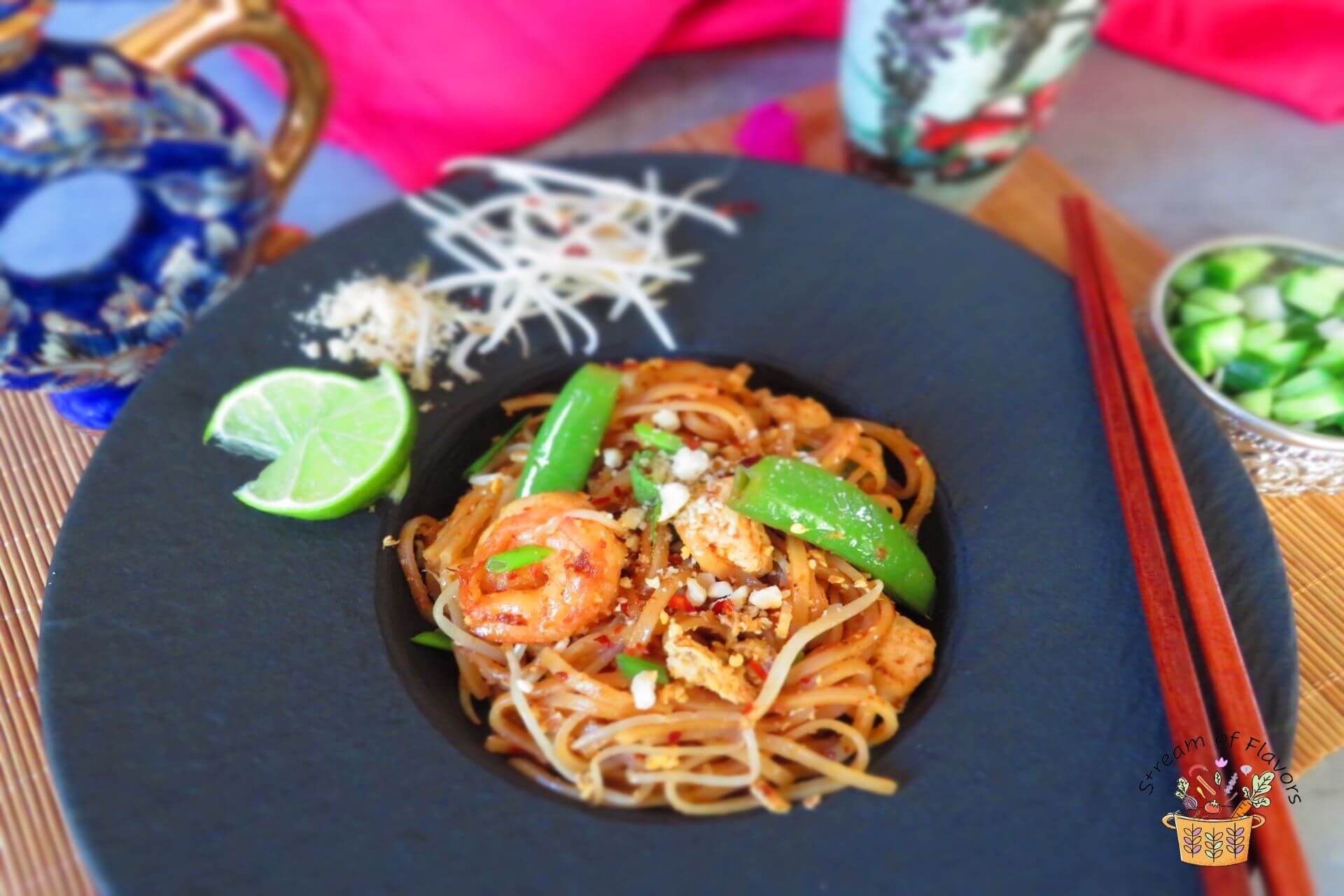
How to make Pad Thai With Shrimp:
1. How to make the curry paste:
- Soak the ingredients for 5 minutes in hot water and grind to a fine paste with very little water.
2. How to make the sauce mixture:
- Soak the tamarind in 4 tablespoons of warm water and strain the pulp. Mix all the ingredients together for the sauce mixture.
3. How to stir-fry Pad Thai With Shrimp:
- Follow the instructions to cook the noodles. I soaked mine in hot water for 10 minutes. I then rinsed the noodles in cold water and then drained and kept aside.
- In a hot wok, add the peanut oil a little at a time. Add the curry paste and sauté for 2 minutes.
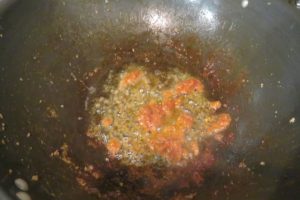
- Add the cleaned shrimp and sauté for 2 minutes.
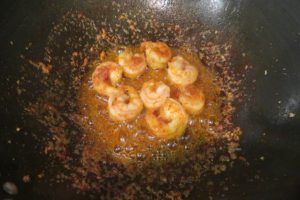
- Toss in the cubed tofu and fry for 2 minutes.
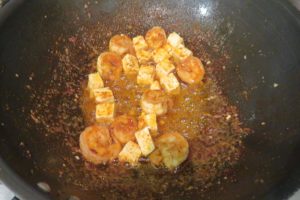
- Sauté the sugar snap peas for a few seconds.
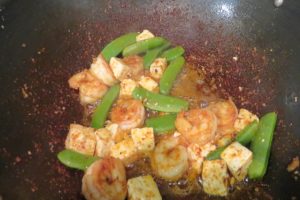
- Add the drained noodles and beansprouts and sauté for 2 minutes.
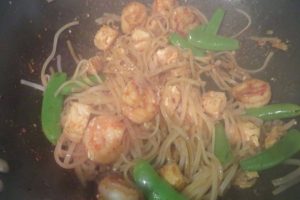
- Move the noodles to one side of the wok and crack the eggs on the other side.
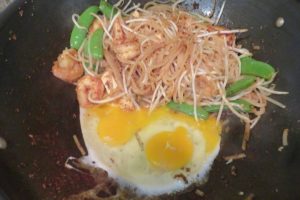
- Mix in the sauces and stir fry for another minute or two. Serve the Pad Thai With Shrimp hot with crushed peanuts, chili flakes, scallions or cilantro and a lime wedge.
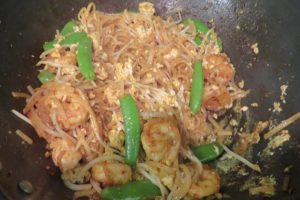
- Cook on high heat and be quick with the stir-fry.
- Brown Pad Thai noodles are starchier than the white ones.
- Noodles must be al dente or slightly undercooked while stir-frying, lest you will get a soggy mass.
- Use oil a little at a time when you notice the ingredients sticking to the wok.
- Make noodles in small batches for best results.
How to serve Pad Thai With Shrimp:
Serve Pad Thai With Shrimp hot on a plate with crushed peanuts and some chili flakes on top and garnish with scallions or cilantro and a lime wedge. A quick salad made with cucumber, shallots, and beansprouts are also served on the side.
How to store:
Pad Thai With Shrimp can be refrigerated for two days or frozen for three months if you have leftovers.
Pad Thai With Shrimp
Equipment
- Wok
Ingredients
For the curry paste:
- 4 dried red chili deseeded
- 4 cilantro roots cleaned
- 2 lemongrass white part
- 2 pearl onion peeled
- 5 cloves garlic peeled
For the sauces:
- 4 tbsp fresh tamarind pulp strained
- 3 tbsp fish sauce
- 4 tbsp soy sauce
- 2 tbsp dark soy sauce
- 1 tsp dark brown sugar
For the Pad Thai stir-fry:
- ½ lb beansprouts
- 1 pack firm tofu
- ½ lb sugar snap peas
- 1 lb jumbo shrimp
- 5 eggs
- 1 pack noodles white
- 2-3 tbsp peanut oil adjust as needed
- ½ cup roasted peanuts coarsely crushed
- a few cilantro sprigs garnish
- 1 tsp chili flakes garnish
- a few lime wedges, scallions
Instructions
How to make the curry paste:
- Soak the ingredients for 5 minutes in hot water and grind to a fine paste with very little water.
How to make the sauce mixture:
- Soak the tamarind in 4 tablespoons of warm water and strain the pulp. Mix all the ingredients together for the sauce mixture.
How to stir-fry the Pad Thai With Shrimp:
- Follow the instructions to cook the noodles. I soaked mine in hot water for 10 minutes. I then rinsed the noodles in cold water and then drained and kept aside.
- In a hot wok, add the peanut oil a little at a time. Add the curry paste and sauté for 2 minutes.
- Add the cleaned shrimp and sauté for 2 minutes.
- Toss in the cubed tofu and fry for 2 minutes.
- Sauté the sugar snap peas for a few seconds.
- Add the drained noodles and beansprouts and sauté for 2 minutes.
- Move the noodles to one side of the wok and crack the eggs on the other side.
- Mix in the sauces and stir-fry for another minute or two. Serve hot with crushed peanuts, chili flakes, scallions or cilantro and a lime wedge.
Notes
- Store-bought tamarind pulp generally does not add flavor to the noodles. Fresh tamarind will yield an aromatic sauce.
- You could also use leftover shredded chicken.
Nutrition


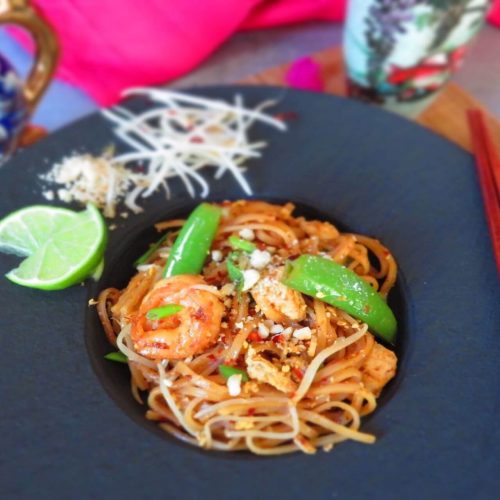





















this is a perfect, healthy recipe for such a traditional dish!
Thanks, Ava!
I love the addition of snap peas! Great recipe!
Turned out great!
Thanks, Abigail!
Thanks for sharing – I had a great time making this!
You’re welcome, Archana!
this was so easy to make in my dorm, thank you!